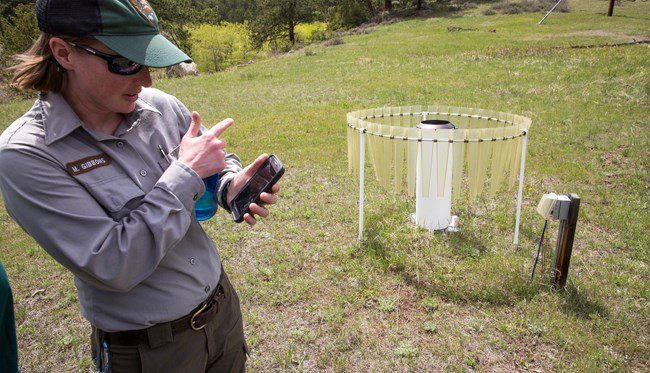|
Visit our keyboard shortcuts docs for details
An air quality scientist describes how we monitor the wet deposition of nitrogen and sulfur. Video courtesy of Mackenzie Reed/NPS Nitrogen and sulfur air pollution is transported through the atmosphere in gaseous and particulate forms. When these compounds are deposited by rain, snow, or fog it is called wet deposition. Too much nitrogen or sulfur deposition can have harmful effects on park ecosystems. We monitor wet deposition in parks by collecting precipitation and analyzing it for nitrogen and sulfur compounds including ammonium (NH4+), nitrate (NO3- ), and sulfate (SO42-). Who is monitoring and where?NPS staff and partners collect wet deposition in parks as part of the National Atmospheric Deposition Program (NADP) National Trends Network (NTN). This multi-agency cooperative network monitors precipitation chemistry at more than 250 sites across the United States and Canada. Many of these monitoring sites are inside parks or are close enough to be considered representative of park air quality conditions. Take a look at the Nitrogen & Sulfur tab on the NPS Air Quality Monitoring map to see where these sites are located. When selecting deposition monitoring sites the NPS considers:
What equipment do we use and how does it work?
Visit our keyboard shortcuts docs for details
Automated precipitation collection bucket system. Video courtesy of Mackenzie Reed/NPS Precipitation is collected using an automated bucket system. When precipitation falls onto the sensor (shown above), a mechanical arm removes the lid, allowing precipitation to collect in the bucket. When the sensor dries, the automated system returns the lid to the bucket to minimize evaporation and sample contamination. 
Photo courtesy of Mackenzie Reed In addition to the bucket collection system, each site also uses an open-faced rain gauge to precisely monitor the total amount of rainfall at the site (shown to the right). The rain gage works by recording the weight of collected precipitation which can be later translated into inches of precipitation received. The wind shield surrounding the gauge prevents updrafts from carrying off snow before it can fall into the gauge. The rain gauge and automated bucket system share a common data logging application used to ensure that the automated bucket system is properly opening and closing when the rain gage is collecting precipitation. How are the data used?Wet deposition data are useful for:
|
Last updated: August 7, 2025
